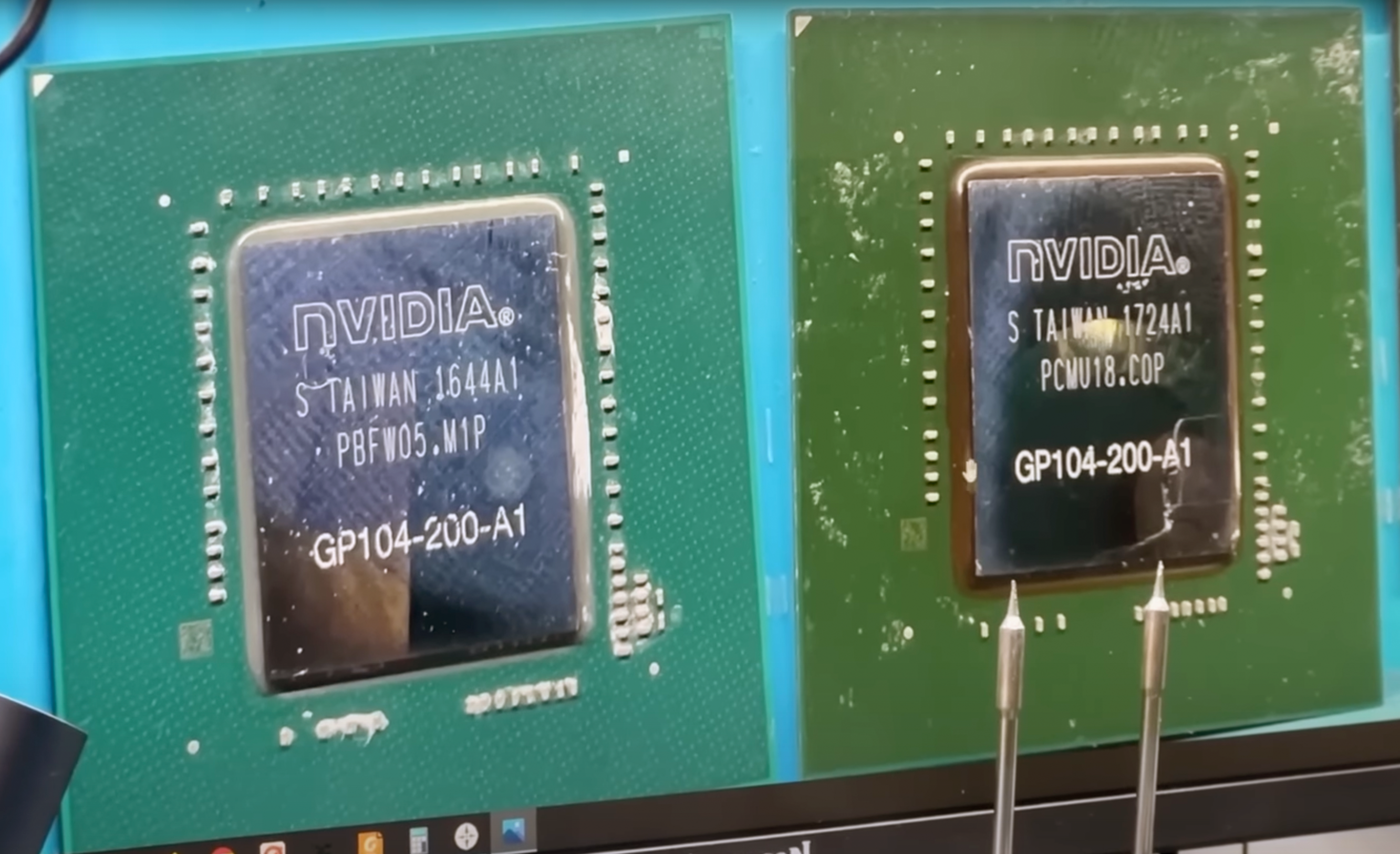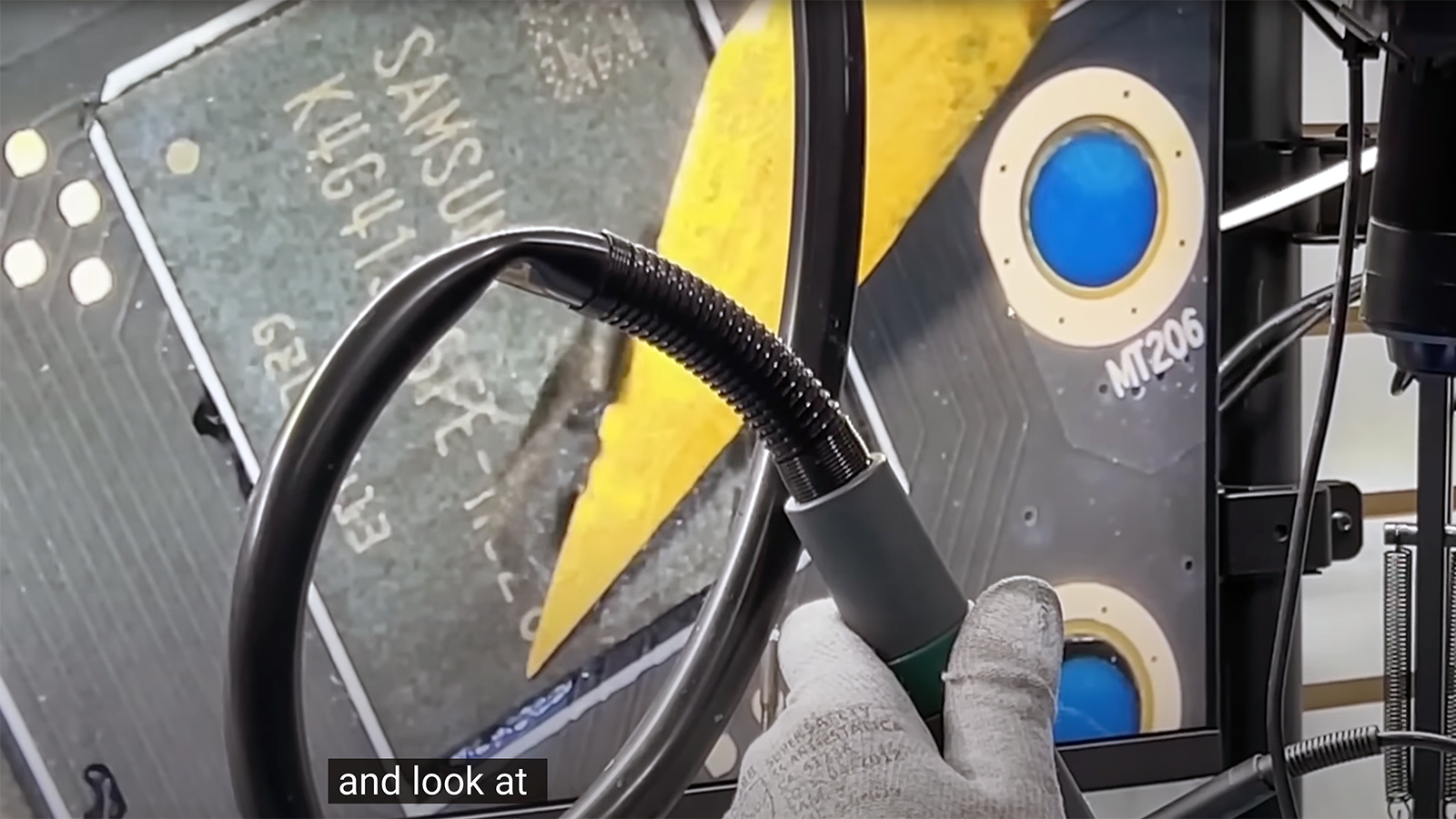Crypto Miners Are Painting GDDR Memory to Make Graphics Cards Look New
Yellowed memory due to overheating? No problem, say some used GPU sellers.
It is not a secret that miners tend to sell graphics cards they no longer need and pretend they are either nearly new or at least have not been used for mining. We've seen reports of miners power-washing large numbers of GPUs in the past. But recently these sellers have seemingly found a new way of tricking gamers desperate for a capable and affordable graphics card: painting the memory on add-in-boards to hide signs of overheating. This is according to reports by Iskandar Souza and TecLab.
There are many ways to tell that a graphics card is not new. Anything from dust accumulation, worn warranty stickers, scratches, oxidized contacts, and a slight change of PCB color are to be expected on cards that have been used for several months or years. Also, a slightly darker GPU substrate and yellowish markings on memory chips indicate that a card has been used for a long time. The latter is something that some miners are now trying to hide.
Missing screws and removed warranty stickers are also clear indicators that a GPU has been tampered with. While in some cases this may be a result of using a third-party cooling system and then switching back to a stock one, in most cases these are indicators that the board was used for mining and then opened up to clean up, change thermal pads/paste, and so on.
Apparently, there are also other reasons to remove a cooling system and then install it back: to resolder a failed GPU or a memory chip, as well as to paint memory chips to make them look newer than they are.
A graphics processor that has been used for a while tends to change color (or its epoxy does) due to high temperatures. That color tends to get significantly darker if the GPU was used for mining and was subject to high temperatures for prolonged periods.
Painting a GPU substrate is a hard task, so it doesn't seem like like anybody is doing that yet. But markings of memory chips tend to get yellowish after prolonged use, because of overheating and/or because they were soldered down in a repair shop. To hide this, some miners are reportedly applying a special tint on DRAM ICs, though this tint can be easily removed to reveal the true color of chips, according to reports.
Resoldering expensive components is something that even official repair facilities do. So if you buy, say, a refurbished graphics card, it may come with a resoldered GPU or a GDDR SGRAM chip. But makers of graphics cards and repair shops do not typically repaint memory ICs to hide that they are not new.
In any case, buying one of the best graphics cards used at a decent discount might sound like an attractive deal, and doing so has always been a risky endeavor. But apparently, miners are employing new tactics to make their heavily used wares seem lightly used or as good as new. So be extra careful when purchasing a used graphics card these days, because years of wear and tear could be hiding just under a surface of paint that's the only thing on the card that's truly new.
Get Tom's Hardware's best news and in-depth reviews, straight to your inbox.

Anton Shilov is a contributing writer at Tom’s Hardware. Over the past couple of decades, he has covered everything from CPUs and GPUs to supercomputers and from modern process technologies and latest fab tools to high-tech industry trends.
-
hannibal Nice...Reply
Car "dealers" tricks has arrived in GPU market...
Well actually they have done this for years, but it is good to remain people that it does exist! -
It's getting better and better. The solution would be to save money and buy a new card, but I doubt people will pass on a huge discount. Soon we might be getting more stories like Kris-Fix published recently.Reply
It makes me happy that even though I bought a mining card, mine is fine and when disassembled I could see dust around vrms. Someone cleaned it, but didn't resort to shady practices. -
Math Geek "i've heard it may not be that good to buy a used gpu, that can't be right. can it??"Reply
i can't stress it enough or loud enough. THERE IS ZERO REASON TO BUY A USED GPU ANYWHERE ON THE PLANET RIGHT NOW, UNLESS YOU JUST WANT TO THROW AWAY YOUR MONEY!!! YOU ARE 100% GUARANTEED TO BE BUYING A MINING CARD AND 100% GUARANTEED TO BE THROWING YOUR MONEY AWAY. -
atomicWAR Between miners and scalpers...they are the bane of consumer graphics cards in regards to consumers. I don't mind a mining card if the person is honest, the price reflects it but most aren't and prices don't. I wish we had better laws in place to protect consumers from these types of purchases.Reply -
DavidLejdar In other words, cryptotokens didn't bring in much money for the miners, which is why they go to great lengths to sell a GPU for a bag of groceries, huh?Reply -
RichardtST ReplyMath Geek said:"i've heard it may not be that good to buy a used gpu, that can't be right. can it??"
i can't stress it enough or loud enough. THERE IS ZERO REASON TO BUY A USED GPU ANYWHERE ON THE PLANET RIGHT NOW, UNLESS YOU JUST WANT TO THROW AWAY YOUR MONEY!!! YOU ARE 100% GUARANTEED TO BE BUYING A MINING CARD AND 100% GUARANTEED TO BE THROWING YOUR MONEY AWAY.
Nah. I needed a turbo card (small case with bad airflow), a 3080, and the only ones available at non-insane prices are the used ones. Got it for about $600 instead of nearly triple that for new. Worth the risk for me. -
PEnns And then we have people here on this forum wondering why their "slightly used / looks new" PGUs stopped working 1-2 days after purchase.....Reply
Or trolls on YouTube blaming AMD drivers for their misfortune with "almost new" cards...all bought from the same scumbag miner!! -
ComputePronto ReplyMath Geek said:"i've heard it may not be that good to buy a used gpu, that can't be right. can it??"
i can't stress it enough or loud enough. THERE IS ZERO REASON TO BUY A USED GPU ANYWHERE ON THE PLANET RIGHT NOW, UNLESS YOU JUST WANT TO THROW AWAY YOUR MONEY!!! YOU ARE 100% GUARANTEED TO BE BUYING A MINING CARD AND 100% GUARANTEED TO BE THROWING YOUR MONEY AWAY.
RichardtST said:Nah. I needed a turbo card (small case with bad airflow), a 3080, and the only ones available at non-insane prices are the used ones. Got it for about $600 instead of nearly triple that for new. Worth the risk for me.
Ditto.
I've personally bought multiple generations of graphics cards over the last 5 years that I'm pretty sure were mined on. They never had problems. I heavily tested them so I could catch any issues well before eBay's 30 day cutoff. The testing turned out not to be necessary in this case, but better safe than sorry!
Ironically, the only bad graphics card I've bought in the last 5 years was one that was NOT mined on. It had water damage because it was in a PC with a leaky AIO liquid cooler. -
Math Geek ReplyRichardtST said:Nah. I needed a turbo card (small case with bad airflow), a 3080, and the only ones available at non-insane prices are the used ones. Got it for about $600 instead of nearly triple that for new. Worth the risk for me.ComputePronto said:Ditto.
I've personally bought multiple generations of graphics cards over the last 5 years that I'm pretty sure were mined on. They never had problems. I heavily tested them so I could catch any issues well before eBay's 30 day cutoff. The testing turned out not to be necessary in this case, but better safe than sorry!
Ironically, the only bad graphics card I've bought in the last 5 years was one that was NOT mined on. It had water damage because it was in a PC with a leaky AIO liquid cooler.
and thus why we have them happily dumping their crap cards on so many people. some may willingly take the risk, do your thing, but these sleezeballs are clearly making every effort to hide the fact from buyers and tricking them into buying their junk. true so many are going into it with eyes wide shut, but it's hard to open their eyes when folks like you will pretend it is actually a good idea.
do you also forget that the reason the gpu's cost 3x what they used to is specifically due to the miners buying them all up allowing the manufacturer's to keep jacking the price up until they are what we see now. your solution to "they cost too much" is to bail out the people responsible when the mining world fell flat.
enjoy being part of the problem :) -
thisisaname If I was going to buy a used 30 series card I would want at least 50% of new price and a from what I seen on ebay prices are higher than this.Reply

